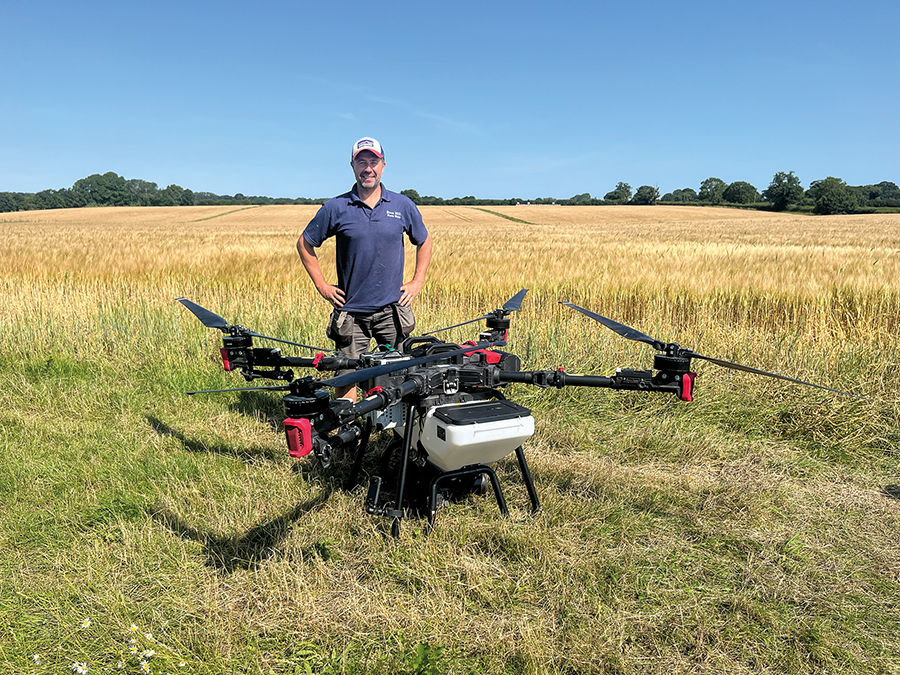Complementing traditional farming methods with drones
22nd August 2024
While drones have been used for crop monitoring for quite a while, there’s some new and exciting potential for other uses. Rachel Hicks reports.

A recent episode of Countryfile which first aired on 7th July 2024 saw Adam Henson travelling to a farm in the Cotswolds to see how an experimental technology could potentially change how he farms his own land.
During the episode, Mr Henson commented that while tractors are essential for any arable farm, and incredible versatile – they can run pretty much any piece of kit you need to grow crops – they’re not cheap to purchase or run. Plus their weight means you need to keep them off wet ground to protect the soil structure.
Mr Henson chatted to Rob Pearson of Auto Spray Systems during the programme, to see if the drones he’s been working with could be useful on-farm.
The drone featured within the episode can carry 50kg of liquid or granular fertiliser, or seed. Mr Pearson explained that he’s used it primarily for cover cropping and intersowing, but also for nematodes onto forestry applications.
However, pointed out Mr Pearson, drones are not designed to compete directly with tractors – but rather, are ideal for hilly or tricky terrain, or when you need to apply seeds, fertilisers or slug pellets when the land is too wet to travel on.
The drone has to be calibrated, and the field GPS-mapped either by drawing it on, or by linking in with the farm’s pre-set mapping system.
By law, the operator has to be within 500m at all times, and have line of sight in case of malfunction.
It travels at around 24kph – covering around 15-20ha per hour – and is calibrated to spread the seed at a specified rate.
By planting the cover crop before harvest, it should establish an understory below the cash crop, meaning there is no bare soil post-harvest and improving soil health.
Case study: Eves Hill Farm, Norfolk
Eves Hill Farm is run by Jeremy Buxton, a third-generation farmer, alongside his wife Kathryn Buxton, and their young son Edward.
Jeremy followed in the footsteps of his grandfather, who bought the farm in the 1960s, and his father. A passion for regenerative farming and producing high quality food for the local community has seen many changes on the farm in the management and farming practices. Jeremy is determined to farm in a manner that regenerates the soils and biodiversity on the farm whilst helping to prevent climate change.
According to Mr Buxton: “Eves Hill Farm is a 100ha mixed farming business. We farm using principles of regenerative agriculture to improve the levels of biodiversity on the farm, and sequester carbon into the soil.
“It is our strong belief that farmers can help save the planet, and this concept is built into the running of the farm and indeed, of the whole of our business. We believe that by focusing on regenerating our soils we can produce healthy plants and livestock and in turn produce nutrient dense food which nourishes our customers.”
Mr Buxton hired Auto Spray Systems and the XAG P100 40,000lb drone to broadcast a diverse, grazable cover crop from Cotswolds Seeds.
Containing tillage radish, mustard, berseem clover, crimson clover, fodder radish, forage rape, stubble turnips and phacelia, Mr Buxton says he worked closely with Cotswolds Seeds to get what he felt was the right mix in term of what the drone could handle in regards to seed size, as well as selecting seed that was suitable for dropping into a standing crop – for example, seed with a really hard casing wouldn’t work as well in this context, when broadcasting onto the surface rather than drilling.
The idea is to not apply the seed more than three weeks pre-harvest, and Mr Buxton was hopeful that the timing was just about right.

When asked why he decided to get a drone involved, Mr Buxton explained: “I thought that in our context as a regenerative farm, it just ticks all the boxes – with the drone causing no soil disturbance, no soil compaction, no negative impact on the land, and critically having that living root in the ground all the time.
“Even before we terminate the barley crop, there will already be a cover crop in the ground and rooting, so in terms of soil biology and soil structure, it’s definitely ticking that box.”
The intention is to graze the post-barley cover crop – but Mr Buxton says it very much depends on how much biomass is there, how it has established, and the weather conditions. In their rotations they have a lot of herbal leys and permanent grazing, so they only graze when the conditions are right.
Before they began spreading, Mr Buxton sent Auto Spray Systems his own field map, which his contractor generated using the Omnia software by Hutchinsons, and they used this to set a GPS-based grid for the drone to follow autonomously. While there are benefits to drones, current restrictions mean they cannot be used to spray pesticides that farmers would typically use; however, Mr Pearson commented that he hopes to see this change within the next 18 months.
But is this the future of farming? Jeremy Buxton says yes, in the right context. “It has to suit your farming system, but there is potentially multiple uses for drones moving forward,” he concludes.
Read more arable news


